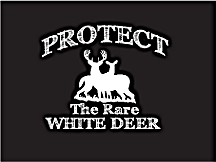
Cruising for White Deer in Leland
How do you know it’s spring in the Leland area? The cranes are back in the marshes, the frogs are singing by Honey Creek, the eagles are on the Leland nest, and it’s time to go looking for white deer.
One of the most fun things to do in March and April is cruise the back roads near Leland looking for white deer. For some, this is a regular pastime, and you can always tell them—they are the ones driving abnormally slow (even for a winding Sauk County road) and they frequently stop.
But timing is important. February is too early to look for white deer. They may come out into the fields in the evening, but with any snow cover, they totally blend in. Good white deer watching requires snow-free ground.
But come March–when the snow starts to melt and you finally have a darker background, when the deer start moving off the bluffs and into the fields, and when the sun gets low in the sky—that’s the time to grab the binnies and hop in the car.
Actually, it’s not too much of a feat to find the white deer. Not that they are so common—far from it. But deer are creatures of habit, so they can often be found in the same places. It also doesn’t hurt that the deer’s white color makes them stand out a mile away.
Large numbers of grayish-brown deer graze the fields at this time. With the snow gone, now they are the ones that are hard to see. But who’s looking? It’s the white deer that totally command your attention.
There’s a double perk to driving the Leland area this time of year. March and April are also the best times to view the incredible sandstone bluffs in the area—before the summer leaves cover their crags and surfaces.
For those from out of the area, the rocks are a scenic revelation. For locals, it’s always nice to travel your own back roads. It gives you a sense of place. If you see a white deer or two, or three or four, or even five or six, so much the better.
By the end of April, though, the show is almost over. Farm work has begun and the fields are getting disked or plowed up. Tractors and humans are disrupting the quiet scene. In another month the does will be dropping fawns and they’re becoming very secretive.
During the summer, white deer sightings are even less predictable. All the trees are leafed out and the corn is as high as an elephant’s eye. It’s hard to see anything—even perfectly white deer.
Fall finds the deer gathering again. Antlers finally make it easy to identify the bucks, and the corn harvest is starting to open fields. During hunting season, though, all bets are off as to where anybody is. The deer become scattered, wary, and much more nocturnal.
In winter, deer habits change again, as snow makes travel more difficult and food harder to find. The same white coat that made the deer so conspicuous in April now gives them the perfect winter camouflage.
Then one day it happens: the snow is gone, the cranes are back, the frogs are singing, the eagle is on its nest, and the deer are in the fields. As the seasons take another spin, so will the white deer watchers. It’s time to grab the binnies and hop in the car.

